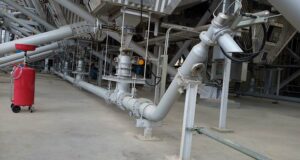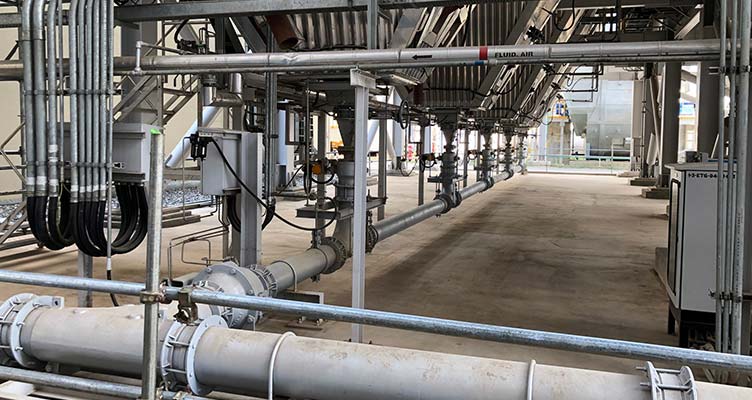A Pneumatic Conveying System uses compressed gas or air to transfer different kinds of materials. It is a method used for transferring bulk granular and powdered materials from one facility to another. The conveying process is simple; the material is confined within the tubes or pipes. These materials are transferred using a combination of pressure differential and airflow from a blower or compressor. Pneumatic conveying systems are widely used in many industries because of their effectiveness and efficiency.
There are two types of pressure developed inside the conveying line, positive and negative pressure. Positive pressure pushes the material from the inlet to the outlet while the negative pressure pulls the material. Both pressures in the pneumatic conveying line transport the materials safely with minimal damage or loss. In some pneumatic conveying systems, both positive and negative pressure exists.
Pneumatic conveyor handling systems are suitable in transporting dry, low bulk density materials such as cement, fly ash, starch, sugar, salt, sand, plastic pellets, lime, plastic resin, plastic powder, powdered milk. Sometimes pneumatic conveying is used in transferring loads, plant transport, and dust control.
Types of Pneumatic Conveying System
All types use the same transfer medium, whether on the Dilute phase, Dense phase, and Pulse dense phase. The difference between them is their mode of generating air pressure, types of material, and conveying procedure.
1. Dilute Phase
The dilute/Lean phase is the most commonly used pneumatic conveying system for transporting material. It uses low pressure &high volume and high velocity to convey a large volume of materials. The dilute phase is suitable in conveying powder with low bulk densities, non-friable and non-abrasive materials. There are two systems used in this phase of the pneumatic conveyor system, positive and negative pressure system.
1.1 Positive pressure system
Uses fans or blowers to generate pressure in the line. It operates above atmospheric pressure and is typically used to convey bulk materials from one station to another in longer distances and greater capacity than a negative pressure system.
1.2 Negative pressure system
Commonly known as a vacuum system, instead of pushing the material, it uses a vacuum to pull the materials. It operates below atmospheric pressure.

2. Dense Phase
Opposite of Dilute Phase, use high pressure and low velocity to convey materials. The materials are contained in a vessel wherein high pressure forces the materials to convey lines and their destination. A dense phase conveyor system is very efficient in transferring friable and abrasive materials. Also, it is suitable for conveying chemicals, coals, food, grains, and limes.
3. Pulse Dense Phase
Pulse dense phase uses low velocity as the material moves in a plug flow fashion. It has a low air consumption, making it very efficient and commonly used in conveying abrasive materials.
Specification and selection criteria
In the selection of a proper pneumatic system, certain factors need to be considered. The equipment should be suitable for the material to be transported. This is a list of basic and important factors that must be considered.
1. Type of Materials
In selecting the proper pneumatic conveying system, the material’s type or nature should be the primary concern. Materials have different characteristics, such as particle size, bulk density, moisture content, abrasiveness, friability, and toxicity. It is very important to know the nature of the material to be conveyed before selecting a pneumatic system.
2. Size of the System
This includes the displacement travelby the material, flow/ feed rate, and the set-up (horizontal or vertical). Possessing knowledge of these variables will help select the pneumatic conveying system and influence efficiency.
3. Vacuum and Pressure
The vacuum system operates below atmospheric pressure and sucks material through the pipeline while it conveys non-abrasive materials. On the other hand, the pressure system operates beyond atmospheric pressure, pushes the material through the pipeline, and conveys abrasive materials.
4. Dilute Phase and Dense Phase
The dilute phase conveys materials at high velocities but low pressure and has material breakage during operation. In comparison, the dense phase conveys materials at low velocities but high pressure.
Cost
The cost of each pneumatic conveying system varies depending on the designs and specifications.
Reference: https://www.iqsdirectory.com/articles/pneumatics/pneumatic-conveying.html
 IND
IND VN
VN CN
CN KR
KR JP
JP